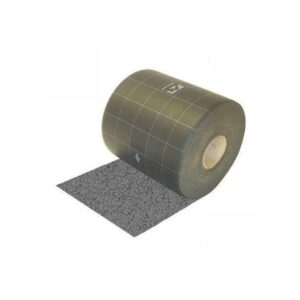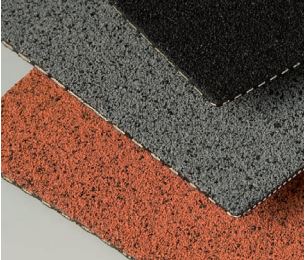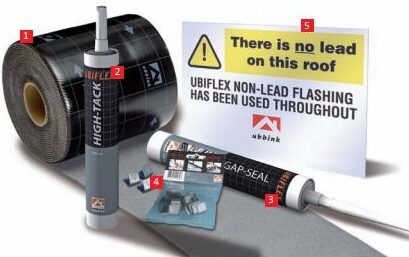Lead flashing has been used for years to prevent the ingress of water into joints, acting as a weather-resistant barrier on buildings.
However, lead has a scrap value of around £1000 but can be sold for £1500 or more, which makes lead flashings a common target for thieves.
Ubiflex lead alternative flashing to the rescue!
The question is:
What exactly is an alternative to lead flashing, why should you use Ubiflex, and how is it installed?
That’s what we’re here to find out! Read on.
Table of contents:
- What is Ubiflex non-lead alternative?
- Benefits of Ubiflex non-lead alternative
- How to install Ubiflex flashing
- Wrapping it up
What is Ubiflex non-lead alternative?

Ubiflex from Ubbink has been developed as an innovative, highly versatile lead alternative, specifically designed for building applications. Ubiflex consists of an aluminium mesh, which has been coated on both sides with a modified bitumen-based mixture, with craft paper and film backing on the underside, and granules on the topside.
The granules come in a range of colours that match or complement traditional building materials, and the lead-grey colour looks just like traditional lead flashing.
Benefits of Ubiflex non-lead alternative
Flexibility
One benefit of Ubiflex is that it is incredibly malleable, just like traditional lead flashing. So, it can be worked and reworked to achieve the desired shape without having any effect on the performance.

Light and quick to install
Ubiflex is up to 80% lighter than lead flashing and can cut installation times by up to an amazing 50%, saving you time and money on labour. This is huge!
Environmentally friendly
Unlike traditional lead flashing Ubiflex flashing is non-toxic, which improves general health and safety when onsite. In terms of the environment, Ubiflex is a sustainable material that can be recycled or even reused if required, thereby helping you reduce your carbon footprint.
Wind resistant
Ubiflex has been tested in controlled conditions, and it has resisted wind speeds of up to a whopping 110mph. Additionally, the product has BBA certification and NHBC approval, so you know it’s designed to the highest British and international industry standards.
Versatile
Ubflex flashing is extremely versatile – it can be used on flashings on walls and chimneys, upstands on flat roofs, side abutments, valley liners and much more.
How to install Ubiflex flashing

Ubiflex is commonly used on refurbishment and lead replacement projects, as well as new builds, and the process is quick and easy.
Here’s a quick overview of the steps:
Step 1: Measure up
First, if there is currently lead flashing in place, remove this. Then, measure the roof – Ubiflex comes in roll widths of up to a metre if required, but it also comes in smaller widths.
Step 2: Prepare Ubiflex flashing
Ubiflex flashing can be easily cut to appropriate lengths with a Stanley knife or with snips. Unlike lead, Ubiflex can be installed in rolls of up to 12 metres long, as it is light and thermal expansion is minimal. However, it may be easier to handle if you work in sections, ensuring there is around a 150mm overlap between sections.
Step 3: Apply Ubiflex
If replacing lead, clean the mortar joint, and then insert 30mm of the Ubiflex flashing into the joint. Then, secure the Ubiflex by using wedges, and roughly dress it into shape – either by hand or with the appropriate lead dressing tools.
Step 4: Dress Ubiflex fully
Once the Ubiflex flashing pieces are secured, the flashing can be dressed more thoroughly, to follow the profiles of the tiles or slates and fit tightly to the roof.
Step 5: Apply adhesive
Once dressed, lift the flashing at the front edge and apply a bead of Ubbink High Tack adhesive to the roof. Proceed to press Ubiflex down onto the adhesive in order to secure the flashing, and create a waterproof and windproof seal.
The last step is to simply apply a bead of Ubbink gap seal into the mortar joints to create a complete seal.
That’s all it takes!
Wrapping it up
Ubbink’s Ubiflex lead-free flashing is becoming a go-to lead alternative for homeowners and tradespeople alike due to its ease of use and quick installation.
What’s more:
It comes in various thicknesses and colours, allowing roofers to match the roof’s appearance if desired or to go for a classic lead-like appearance.
The different thickness options also make Ubiflex lead alternative suitable for various applications such as creating soakers, valleys and trims, resulting in a hassle-free choice.
For any further questions on Ubiflex as a lead alternative or advice on your latest project, feel free to call our team of experts on 01752 692 760 or use the live chat and they will be more than happy to help.











